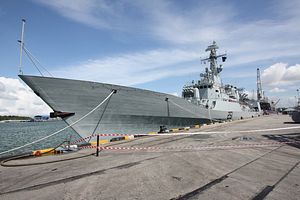Later this week, a Pakistani vessel will pay a three-day goodwill visit to the Philippines as part of a broader voyage that also includes other key Southeast Asian states Thailand and Malaysia. The interaction, which was confirmed by Philippine officials on Tuesday, will put the spotlight on a relationship that usually gets little media mention for its own sake, beyond the implications for major power dynamics in the region.
Pakistan and the Philippines share a contemporary diplomatic relationship that officially dates back to 1949 and both sides have pursued some areas of common interest. However, ties remain quite limited to this day, whether viewed bilaterally, through basic metrics like trade and investment, or in terms of wider multilateral cooperation. Islamabad still only has sectoral dialogue partner status in the Association of Southeast Asian Nations (ASEAN) as opposed to the full dialogue partner status accorded to major partners like India.
But that has not stopped ongoing efforts by some actors on both sides, including among the business community, to try to boost ties further, particularly in 2017 as ASEAN has been commemorating its 50th anniversary and the Philippines has been chairing the grouping. Various countries have used this as an opportunity to focus on strengthening ties with Manila, and Pakistan is no exception (no doubt Islamabad is also aware of India’s extensive engagement with ASEAN states as well on this front).
At the same time, some media accounts have also been keen to play up the common thread of two key Asian countries – both once former members of the now-defunct Southeast Asia Treaty Organization (SEATO) during the Cold War – moving closer into China’s orbit through initiatives like the Belt and Road Initiative (BRI), even though this overlooks both the significantly tighter ties Islamabad and Beijing have forged over a longer period of time and vastly oversimplifies the foreign policy currently adopted by Philippine President Rodrigo Duterte (See: “The Real Trouble with China’s Belt and Road”).
Pakistani naval visits to Southeast Asian countries are hardly a new thing. Nonetheless, the PNS Saif’s visit has put the Islamabad’s ties to the Philippines as well as with Southeast Asia more broadly in the spotlight. The PNS Saif, the third frigate of the Zulfiqar-class vessels built in Shanghai as part of a longstanding and continuing line of defense cooperation between Islamabad and Beijing, was handed over to the Pakistan Navy in September 2010.
Though the voyage of the vessel – which is listed as being 123 meters long, 13.2 meters wide and 30.7 meters high, with around 273 personnel on board along with an on-board helicopter – also included other stops such as Colombo and Shanghai, several Southeast Asian states were also in the mix. Saif is set to visit Malaysia, the Philippines, as well as Thailand, where, as I had noted previously, there were a series of naval commemorative activities held by Asian states (See: “ASEAN’s First Naval Exercise in Perspective”).
Of the stops the PNS Saif has made, the China one – its first visit to Shanghai, where it was first built – has unsurprisingly received outsized media coverage. Official statements cast it as part of brotherly relations between the two countries, and both sides also carried out a joint naval exercise as well, which was the fifth in its series.
But thereafter, the ship was also scheduled to move to a couple of other Southeast Asian states, following its earlier stop in Thailand where it had participated in the International Fleet Review organized by the Royal Thai Navy (RTN). From December 14 to 17, the PNS Saif will move on to the Philippines for what is officially billed as a three-day goodwill visit. According to the Philippine Navy, in line with protocol, the ship will be met by the BRP Rajah Humabon off Corregidor Island and will then arrive at Pier 15, South Harbor, Manila on Thursday and stay through the weekend.
No further details were disclosed by Philippine officials as to the interactions that would occur between both sides as the vessels dock, such as exchanges, exercises or other activities. But as the we see this play out over the later part of the week, there will no doubt be some scrutiny on both the visit and the wider geopolitical context.
































